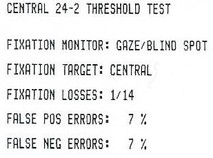
Reliability of visual field test & how best to perform it
If you have been referred by your optician and or your GP with suspicion of Glaucoma, you will be required to have a visual field test on the day or before the clinic appointment. Mr Raj might also advise you visual field tests to monitor your Glaucoma if you are already diagnosed with it. To take the visual field test, you will be seated with your head in a chin rest to maintain a stable position in front of the hemispherical bowl like machine. The person giving the test will then request that you look straight ahead at a small steady light (target light) and not move your eyes. The test is done with each eye separately.
As you will be looking at this steady light (fixed target light), small white lights are flashed on and off around it (above, below, or to the side). These flashes occur one at a time. The location of the test lights corresponds to locations on the retina which is the light-sensitive layer at the back of your eye. The optic nerve that connects your eye with the visual centre in the brain is made of a bundle of about 1 to 1.5 million nerve fibres. All these nerve fibers in the optic nerve, including the ones, which are damaged in glaucoma, originate from the retina.
The primary purpose of the visual field test is to determine how bright a flashing light must be at each particular location in order to be seen. In every visual field test, there will always be some flashes, which are too dim for even normal eyes to see. Therefore, please don't be concerned by this. Results obtained from the test are compared to what is known about visual field tests in normal eyes (without Glaucoma). In general, the ability to detect these flashing lights is reduced at characteristic locations in glaucoma (also called reduced sensitivity). In other words, the lights need to be brighter before they can be seen.
Visual field is one of the most important tests in Glaucoma management and monitoring. But, for any visual field to be of any use, it has to be performed well and as per the instructions. If you look at the left top corner of this information sheet, you can see the reliability indices which are under 20% (usual cut off for reliability) and has acceptable reliability. Mr Raj would also like to inform you that there is a 'learning curve' and usually you will get better with each test.
Visual field testing (Perimetry) is a subjective psychophysical test requiring the patient's cooperation, effort, and communication. As in any diagnostic test, the response to a specific question has an associated error. It is therefore quite important that you as a patient perform this test to the best of your ability.
Mr Raj would advise you the following points to help you perform visual field tests with good reliability:
1. You should be relaxed and well rested. If you are tired or unwell, you may call the number on the appointment letter to postpone the test to a later date.
2. You should make sure you are seated at in front of the visual field test machine as comfortably as possible. The tests often take about 15 minutes to complete in each eye; so your comfort level is important. Let the person giving the test know if you feel uncomfortable or hunched over or if the chin rest is too high.
3. You must always look at the target light. The location of the test lights during the test corresponds to locations on your retina. If you look away from the target or the fixation light, the machine keeps a track of this and reduces the reliability of your test result (‘Fixation losses’ in the reliability indices).
4. You should ideally let the technician know if you need to take a break in order to scratch your nose, cough, feel fatigued and want to take a little rest. If you take the test when you are not settled or not in full attention, your test reliability will go down. ‘False negative’ errors might increase in the reliability indices if you are tired, fatigued or inattentive.
5. Please don’t be alarmed if you do not see all the lights. In every test, there will be lights that even someone with normal vision and without glaucoma will not be able to see (this is how the test is designed). If you happen to press the button even when you do not see the light, the machine can interpret this as being ‘False positive’ (= Trigger Happy) in the reliability indices and reduce the reliability of your visual field test.
6. If you have droopy eyelids ask the technician to tape your upper eyelid up as droopy eyelids can lead to erroneous constriction of your upper visual field.
7. Please bring your up to date glasses or contact lens to the test as your eyes must be fully corrected to maximise the information that the test will provide.
Private & NHS patients
How to see Mr Raj
For private patients & referrals
Mr Akash Raj
Consultant Ophthalmologist, Glaucoma specialist & Cataract surgeon
Stourside Hospital (part of West midland Hospital)
60 Bradley Road
Stourbridge
DY8 1UX
01384 505 183
(Alternate:
Monday Evenings)
Appointments:
01384 912966
Private Secretary: Tara Ralph : 01384 632 636
Mr Akash Raj
Consultant Ophthalmologist, Glaucoma & Cataract specialist.
For NHS Referrals through GP/Opticians
Mr Akash Raj
Consultant Ophthalmologist (Glaucoma Lead)
Pensnett Road
Dudley
West Midlands
DY1 2HQ
Phone: 01384456111
Extn. 5815 (NHS Secretary: Lyn Eaton)

